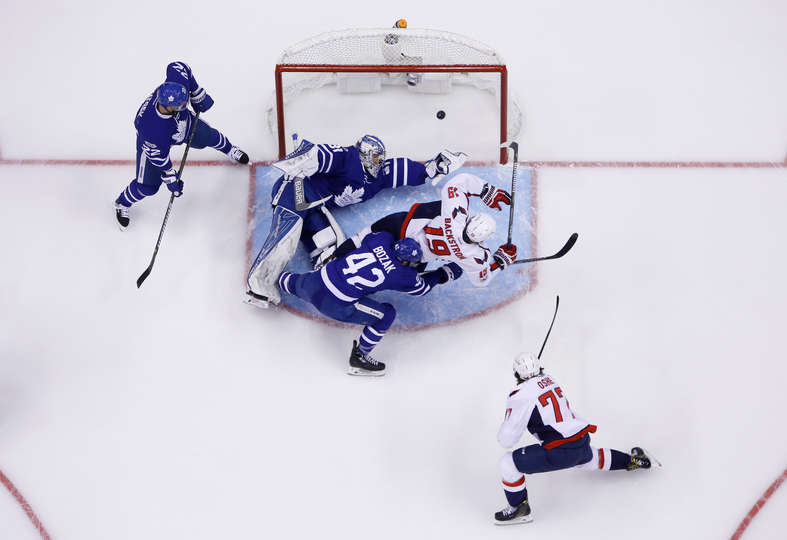Frederik Andersen summed up Game 4 best: “We didn’t play anywhere close to what we’re capable of… We beat ourselves.”
And yet the Washington Capitals only won the game 5-4.
All things being equal, Game 4 is one neither team should leave feeling too great about. Washington played well for half of the game and ultimately took care of business, but the Leafs still managed to put a scare in them while playing their worst game in weeks. For Toronto, it is a disappointing effort in a game where they could have held onto home-ice advantage and took a 3-1 series lead. They put only 15 shots on net through two periods. After the game, Mike Babcock admitted as much, saying, “It is a lost opportunity. It doesn’t [just] feel like it… it is.”
If we sort through all the noise, this was the first game that featured actual personnel adjustments.
In the first three games, the matchups generally held steady and neither coach really juggled the lines other than the odd shift, usually after a special teams event. Barry Trotz started the party by swapping Tom Wilson for Brett Connolly. It seemed like an innocuous move to some, but it paid off huge with Wilson sparking some third line production, giving Washington three dangerous lines compared to the two they had been rolling steadily.
More subtly, this was also the first game in which Washington played their top pairing against Auston Matthews for the majority of the game (note: Matthews’ goal was against the Brooks Orpik – Kevin Shattenkirk pairing). In the first three games, Washington used the John Carlson pairing primarily against what is really the Leafs‘ top line and instead used their top pairing of Dmitry Orlov – Matt Niskanen against the Kadri line. The Matthews line was running them over, including a spectacular game three, and Trotz shifted around his defense in response. Here’s a quick look at the 5v5 ice time matchup:
| Time on Ice vs. Matthews | John Carlson | Matt Niskanen |
|---|---|---|
| Game One | 9:16 | 6:30 |
| Game Two | 9:43 | 9:37 |
| Game Three | 6:49 | 5:10 |
| Game Four | 3:27 | 11:48 |
Babcock responded in the third by switching Connor Brown and William Nylander around, which at least gives the Leafs Nylander against either Brooks Orpik or Nate Schmidt down the wing.
Washington also had a 1-1-3 going in the neutral zone (which the broadcast mentioned during the game) and were able to slow the game down for large stretches of time by angling them off instead of pressing all the way up ice and getting burned on the fast break (which we noted in Game 1 here).
In the third period, Washington played against the clock and almost got burned. Give the Leafs this: They don’t quit.
Now the fun really begins. Players are getting shifted around, strategies are being visibly tweaked, and we are now in a best of three. This is just getting good.
Notes
– The first Washington goal of the game – the TJ Oshie tap-in – is a good example of what the Capitals have been trying to do all series. They want to cycle it to the point and have all their forwards crash the net. This goal was off a faceoff, but when Nate Schmidt got the puck at the point, he didn’t even shoot it on net; he slid it along the ice wide of the net where Niklas Backstrom was. When Schmidt got the puck at the point, Washington had three forwards below the top of the circle ready to cause havoc. This is a lot different than a team like the Leafs, who love the high screen and tip play (think of the Brown goal against Pittsburgh).

– Washington had 27 shots on net in this game and 12 of came from defensemen.
– With Polak out for the year, the Leafs have used Martin Marincin on the right side. He has been getting a lot of credit for his PK work in this series due to some big shifts, although he has always been effective there. I can’t recall seeing him play much on the right side of the PK, however, and he looked unsure of himself before the Ovechkin goal. Every Leaf was on the opposite half of the ice from Ovechkin when the puck went in the corner, and all Washington did was move it up top and across – that’s far too easy. It is not particularly Marincin’s fault (probably more on Brown as the high forward); I just thought it was interesting that they elected to move the guy who has barely played in 2017 out of position even more.
– Make that four goals in 12 PP attempts so far this series for Washington. They only had the one PP in this game. If there is one way to stop a good PP, it can definitely be, ‘don’t take penalties.’
– When the Leafs had the 5v3 to start the third, I thought we might see Rielly QB’ing it. The Leafs didn’t give Rielly much PP time throughout the season, but he generally saw the ice with the two-man advantage, including this goal against the Flyers. Toronto had their chances on the 5v3 so it wasn’t like they didn’t execute at all, but Gardiner was trigger shy including a cross-ice pass where he could have walked and hesitated instead.
– I don’t remember ever seeing Matthews-JVR-Bozak-Nylander-Gardiner as an overall PP unit, either.
– Mitch Marner may have had a nice stat line of two assists and three shots on goal for the night, but Babcock knows he’s struggling. He only played 13:26 on the night and has the lowest CF% on the team in the playoffs at 40.17% while playing soft minutes on a scoring line. He was flying in Game 1 and I thought he was their best player, but since then, he hasn’t had much jump (other than the great Ovechkin backcheck) or been very dynamic carrying the puck through the neutral zone; instead, he’s regularly settling for dump-ins on a line that has trouble retrieving. I floated this before the playoffs and I’m still wondering about it: He’s the only player on the team who didn’t play pro hockey last season. The grind might be getting to him.
– One thing the Leafs have done a good job of is smart dump-ins. There was a great example in game three with the Hyman chip in and retrieval on the Nylander goal, and the Leafs have been doing it all series; the soft chip to the corner, or even soft chip cross-ice if the far side winger has speed. The Leafs flip pucks to open space all over the rink and try to create races against a slower Washington team. One thing the 1-1-3 does is make the Leafs chip it in from further, which gave the Caps more time to get to the puck and break it out clean.
– No Matthews on after the Leafs brought it to 5-4 followed by a lengthy review was a curious move. Nazem Kadri actually led the forward group in ice time for the first time this playoff.
5 Questions for Game 5
1. Do Nylander and Matthews reunite? Babcock shifted around Nylander and Brown, which is something he has done throughout the season for long periods of time. It is not inconceivable that he’d do it again. I think it’s highly likely that we see the top three lines revert back to what they’ve been all series, but if the Leafs have another poor start, it also wouldn’t surprise me if that swap was the first domino to fall in order to shake things up.
2. Is there a chance Nikita Soshnikov draws in? We noted the penalty kill issues above in the notes, and Soshnikov was one of the best penalty killing forwards on the team this season due to his speed and anticipation. Soshnikov has been back and practicing according to reports, and the Leafs are already down one of their mainstays on the PK for the season in Roman Polak. If Soshnikov is healthy, they are just willingly sitting one of their better PK players on a unit that is costing them. I think a Soshnikov-Boyle-Kapanen fourth line would be great in this series, but the Leafs would likely keep the veteran Matt Martin in and sit Kapanen.
3. Failing a personnel change, are the Leafs going to make any changes to their PK? Washington is having their way with the Leafs at 5v4, either scoring or simply missing their opportunities. I broke the Caps PP down before the series and the Leafs need to get a lot more aggressive on the wall, and a lot more decisive on their rotations. If they don’t, Washington will continue to pick them apart.
4. Are the Leafs going to shift around anyone else up front as a surprise? The one player that stands out to me is JVR, who has three points and 15 shots on goal in the four games so far. In Game 4, he only played 14:30, which was eighth most on the team ahead of only the fourth line and Mitch Marner among forwards. Scoring hasn’t exactly been the Leafs issue so far, but JVR has been playing well for weeks now and has earned more ice time.
5. How is the defense going to shake out in game five? The group of six is pretty much set and not changing at this point, barring another injury. Connor Carrick is only used 5v5 and Marincin is used for PK and defensive situations, while the top four is set. What we’re talking about here is how the ice time is structured – Gardiner played a little over four more minutes more than Rielly to lead the group, which is the biggest gap between the two since the playoffs started. They are asking a lot of both, but they clearly favoured Gardiner over Rielly in Game 4. We’ll see what happens moving forward.




![Sheldon Keefe Post Game, Leafs 3 vs. Bruins 2: “I loved [the Matthews] line, and I loved a lot about our game all the way through the lineup” Sheldon Keefe, Toronto Maple Leafs post game](https://mapleleafshotstove.com/wp-content/uploads/2024/04/keefe-pg-game-1-218x150.jpg)


























![Sheldon Keefe Post Game, Leafs 3 vs. Bruins 2: “I loved [the Matthews] line, and I loved a lot about our game all the way through the lineup” Sheldon Keefe, Toronto Maple Leafs post game](https://mapleleafshotstove.com/wp-content/uploads/2024/04/keefe-pg-game-1-100x70.jpg)



